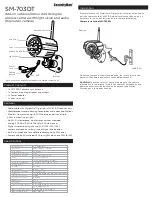
3
You can connect a TV or other video device (NTSC or PAL format) to the camera to monitor or record camera images. Connect the video device as shown below.
The camera’s external I/O interface allows you to connect 2 devices (such as sensors, motion detectors, etc.) that can be used to trigger the camera’s image
buffering and transferring features (see Section 2 Using Triggers to Buffer and Transfer Images in the Operating Instructions on the CD-ROM).
The external I/O interface has 6 terminals.
Mounting the Camera
Three mounting methods are available, as shown here. Confirm which side is the top and bottom of the camera when mounting; do not mount the camera upside
down. Consult an authorized dealer for mounting.
Connecting a Video Device
Note
• Analog video output is disabled by default. See 7.5 Controlling the Analog
Video Output Signal in the Operating Instructions on the CD-ROM for
more information.
Connecting External Sensors
Circuit Diagram Example
Caution
• The external I/O interface is not capable of connecting directly to devices
that require large amounts of current. In some cases, a custom interface
circuit (customer-provided) may have to be used. Serious damage to the
camera may result if a device that exceeds its electrical capability is
connected to the external I/O interface.
• Low voltage/current circuits and high voltage/current circuits are used in
the camera circuit. All wiring should be performed by a qualified
electrician. Incorrect wiring could damage the camera and cause a fatal
electric shock.
• External devices connected to the camera’s output terminals cannot be
controlled in the event of a network error or failure. Keep this in mind when
connecting door locks, heat-emitting devices, or other devices that may
be dangerous if they cannot be controlled.
Terminal
Description
G
GND terminal.
1
External sensor input 1. The camera can be triggered by either an open circuit
or a GND short-circuit.
G
GND terminal.
2
External sensor input 2. The camera can be triggered by either an open circuit
or a GND short-circuit.
3
External device control output. Allows you to control an external device using
the output buttons in the camera’s operation bar (for example, turning a light on
or off).
• This terminal’s behavior can be changed (see 7.4 Controlling the External
Output Terminal in the Operating Instructions on the CD-ROM).
• This terminal is an open collector circuit. The maximum drawing current is
the same as terminal 4. Do not exceed the voltage of the terminal 4.
4
DC power output terminal.
• 10.5–13 V DC
• Maximum load drive is 100 mA.
Note
• Do not push strongly on the external I/O interface with the pointed object. The
external I/O interface may get stuck into the unit, and you may not be able to
use it.
Caution
• Do not drive the screws into a soft material. Drive the screws into a secure area
of the wall or ceiling, such as a column, otherwise the camera may fall and be
damaged.
• Make sure you attach the safety wire when mounting the camera, to prevent
the camera from falling.
Note
•
For BB-HCM715:
The camera is intended for indoor use only and should not
be mounted outdoors.
•
For BB-HCM735:
If you install the camera outdoors, the external microphone
or speaker must be outdoor compatible.
• Use screws that are appropriate for the material of the wall or ceiling.
• The included screws are for use with wooden walls or ceilings only.
• To ensure that camera images are displayed properly, do not mount the
camera on an incline. Mount the camera so that it is perpendicular to the floor.
Do not mount the camera upside down.
• Mounting and cabling instructions described in this document follow generally
accepted guidelines suitable for residential installations. In some areas,
commercial and industrial installations are regulated by local or state
ordinances. For such installations, contact your local building department or
building inspector for more details.
• Camera images can be viewed in relatively dark areas, however, image quality
decreases when viewing dark images. We recommend using supplemental
lighting for best results.
• Prolonged exposure to direct sunlight or halogen light may damage the
camera’s image sensor. Mount the camera appropriately.
• When mounting the camera, make sure to wrap the AC adaptor cord (if used)
and other cables (external microphone or speaker cable, video cable, etc.)
around the hooks as shown to ensure secure connections.
•
For BB-HCM715:
To suit the area in which you will install the camera, you
can attach the provided SD Card Cover (Hard type), in order to help
prevent SD card theft. (Not all forms of theft can be prevented.)
For video device
External I/O interface
Light
Door Sensor 1 (Alarm 1)
Door Sensor 2 (Alarm 2)
Relay
Camera
12 V*
2
3
4
G
1
G
*DC 10.5 V–13 V
Hook for AC adaptor cord,
video cable, external I/O
interface wires
Hook for external
audio cables
SD Card Cover
(Soft type)
SD Card Cover
(Hard type)
To video device
Video cable
(
φ
3.5 mm plug)






















